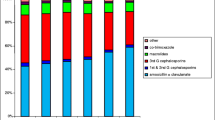Summary
Background
The utilisation of antibiotics in Italy is above the European average. This represents a concern because of both the possibility of abusing such drugs, and the risk of developing resistance. Third generation parenteral cephalosporins are among the antibiotics at higher risk for improper use, also corresponding to an increase in healthcare costs. The Italian Commissione Unica del Farmaco (CUF) has introduced (1994) some guidelines to limit the prescription of parenteral antibiotics in the outpatient setting.
Objectives
To evaluate the trends in parenteral cephalosporins consumption and costs versus oral antibiotics (penicillins and fluoroquinolones), pointing out the effects of the CUF guidance.
Methods
We only considered the most commonly used cephalosporins, chosen on the basis of their relevance for healthcare costs. The same criterium was followed when selecting oral penicillins and fluoroquinolones. Data related to the overall outpatient consumption (number of packages) of such drugs were used when analysing the demand. The content of each package was converted in overall DDD and normalized to DDD/1000 people/die. We also evaluated the demand and costs in the field of the lower airways infections.
Results
The demand for antibiotics for the treatment of lower airways infections has increased sistematically in the decade 1993–2002 (5% yearly), but the share of parenteral cephalosporins is decreasing since 1996. Cephalosporins have a higher cost (€ 20,8 per DDD in 2002) compared to oral antibiotics (fluoroquinolones: € 3,7 per DDD; penicillins € 1,1 per DDD). Compared to 1993, such a cost per DDD has dropped for parenteral cephalosporins (−19,4%) and for fluoroquinolones (−19,6%), while it has increased for oral penicillins (+22%). Despite the increase in demand, the overall expenditure for treatment of lower airways infections, after reaching a peak in 1997 (€ 318 millions), remained roughly constant until year 2000 (€ 311 millions) and then decreased by about 18% from year 2000 to 2002.
Conclusions
CUF guidance was altogether beneficial, promoting appropriate patterns of drug consumption in the outpatients setting, with a positive trend towards reduced demand of parenteral cephalosporins and positive effects on the overall expenditure.
Similar content being viewed by others
Bibliografia
Cars O, Molstad S, Melander A. Variation in antibiotic use in the European Union. Lancet 2001; 357: 1851–3
Traversa G, Bianchi C, Da Cas R, Venegoni M. L’uso degli antibiotici soggetti a Nota in Italia. BIF 2002; 1–2: 246–56
Trevisani L, Sartori S, Putinati S, et al. Antibiotics in acute bronchitis and exacerbations of chronic bronchitis — What is general practitioners’ habit? Chest 1997; 111(6): 1788–9
Vaccheri A, Castelvetri C, Esaka E, et al. Pattern of antibiotic use in primary health care in Italy. Eur J Clin Pharmacol 2000; 56(5): 417–25
Scaglione F. Antibiotici orali vs antibiotici iniettivi. Levofloxacina: le ragioni di una scelta. Giornale Italiano di Malattie del Torace 2002; 56(5): 1–7
CeVEAS (Centro per la Valutazione dell’Efficacia dell’Assistenza Sanitaria). Gli antibiotici nelle infezioni delle vie respiratorie. Pacchetto informativo n° 3, Modena, 2001 (Aggiornato al febbraio 2003)
Mazzaglia G, Caputi A, Rossi A, et al. Exploring patient- and doctor-related variables associated with antibiotic prescribing for respiratory infections in primary care. Eur J Clin Pharmacol 2003; 59(8–9): 651–7
Bollettino d’Informazione sui Farmaci (BIF). Settembre-Dicembre 2000; n. 5–6: 2–4
SPM. Servizio Prescrizioni Mediche — IMS Health, Milano, 1993–2002
Messori A. Analisi dei consumi ospedalieri. Giornale Italiano di Farmacia Clinica 1993; 7(3): 123–33
CERGAS (Centro di Ricerche sulla Gestione dell’Assistenza Sanitaria). Osservatorio Farmaci 2002. A cura di Jommi C. Milano, Rapporto n. 11; 2003
Lucioni C, Donner CF, De Benedetto F, et al. I costi della broncopneumopatia cronica ostruttiva in Italia. Presentazione della prima fase dello studio ICE. Pharmacoeconomics-Italian Research Articles 2004; 6(1): 5–14
Pea F, Bettoncelli G, Richeldi L, et al. Valutazioni in merito alla appropriatezza della prescrizione degli antibiotici iniettabili e proposta di ambiti e modalità di intervento. Infezioni in Medicina, 2004; in corso di stampa
CReVIF (Centro Regionale di Valutazione e Informazione sui Farmaci). Silvani C, Poluzzi E, Motola D, Vaccheri A (a cura di). Rapporto sulla prescrizione di farmaci in Emilia Romagna 2000–2001. Bologna, luglio 2002: 170
Quintiliani R. Pharmaceutical reimbursement policy and physicians prescribing patterns. A case study on oral and injectable cephalosporins in Italy. Today’s Therapeutic Trends 1997; 14: 241–50
Author information
Authors and Affiliations
Corresponding author
Additional information
I peer reviewers, per questo articolo, sono stati coordinati da Albano Del Favero.
Rights and permissions
About this article
Cite this article
Lucioni, C., Saramin, C. & Marchetti, F. Modalità di prescrizione in Italia degli antibiotici iniettabili e orali nel trattamento delle infezioni delle vie aeree inferiori negli anni 1993–2002. Pharmacoeconomics-Ital-Res-Articles 6, 59–67 (2004). https://doi.org/10.1007/BF03320624
Published:
Issue Date:
DOI: https://doi.org/10.1007/BF03320624




